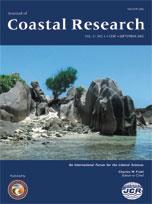“Sabkha” is a term used to describe the coastal flats and salt marches deposited in lagoonal areas under arid conditions. In this study, water and sediment samples (n = 51 and 182, respectively) were collected from sabkhas systems of the Red Sea coast, which extends between Jeddah city and the town of Yanbu Al-Bahar and is bounded by latitudes 21°30′ and 24°00′N and longitudes 38°00′ and 39°30′E. The collected sediment samples were subjected to sedimentological and mineralogical analyses using grain size and X-ray diffraction techniques. The water samples were subjected to hydrochemical analyses using several standard procedures. The study found that climatic conditions in the Red Sea coastal plain sabkhas lead to the formation of marine brines of magnesium-sodic to chloride type with neutral pH value. Because of the evaporation of the groundwater, the evaporite minerals, especially aragonite, halite, and gypsum, were precipitated. The present study shows that this resulted in an increase in the Mg 2/Cl−1 ion concentrations and the formation of protodolomite mainly in the sediments of the supratidal flats. The reported results indicate that the precipitation of the evaporite minerals and the early diagenetic dolomitization caused decrease in sulfate concentration and the Mg 2/Ca 2 ratios in the water of the supratidal flats. The study also found that more than 50% of the Na 1 ions were precipitated as halite as indicated from the average value of Na 1/Cl−1 ratios, which is lower than 0.75. The absence of clay beds in the sediments overlying the water table is probably the reason for the similar potassium ion concentrations in both upper intertidal and supratidal flat waters in addition to the Red Sea water. The relatively low concentrations of sulfates in the water of the supratidal flats of the studied sabkhas in comparison with their concentrations in the water of the upper intertidal flats are probably due to the precipitation of gypsum in the sediments of the supratidal flats of these sabkhas. The slightly high concentrations of bicarbonates in the water of the studied sabkhas are due mainly to the precipitation of carbonates, especially aragonite, as well as to the low pH values of these waters. The reported results can be considered as documentation of the hydrogeochemical characteristics of the Red sea sabkhas and could be useful for planners and researchers interested in the Red Sea coastal systems.
How to translate text using browser tools
1 September 2005
Water Chemical Characteristics of the Red Sea Coastal Sabkhas and Associate Evaporite and Carbonate Minerals
K. M. Banat,
F. M. Howari,
K. A. Kadi
ACCESS THE FULL ARTICLE
dolomite
evaporite
hydrochemistry
ionic ratios
Red Sea
sabkha





